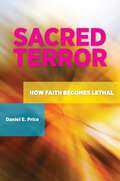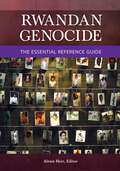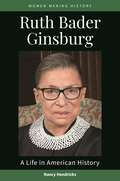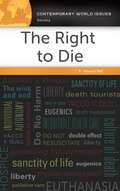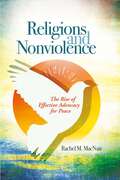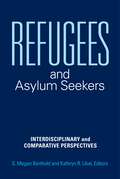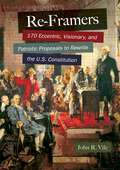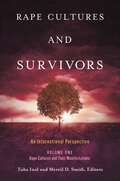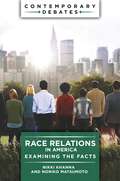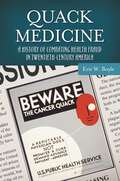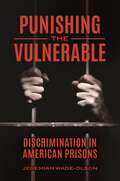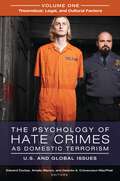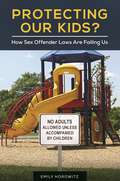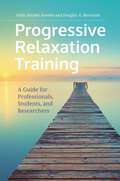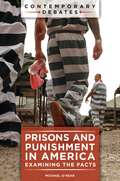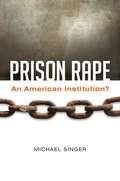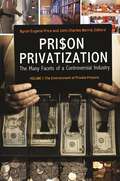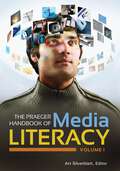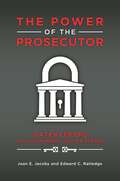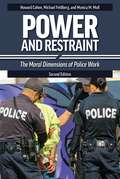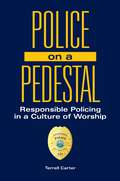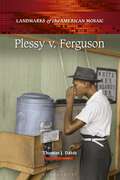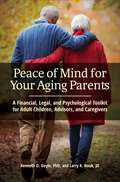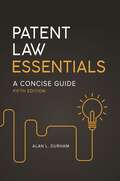- Table View
- List View
Sacred Terror: How Faith Becomes Lethal
by Daniel E. PriceThis book places the current wave of religion-based terrorism in a historical perspective, explaining why religion is associated with terrorism, comparing religion-based terrorism to other forms of terrorism, and documenting how religion-based terrorism is a product of powerful political, socioeconomic, and psychological forces.Religion-based terrorism is perceived as one of the most significant threats to U.S. homeland security in the 21st century. Sacred Terror: How Faith Becomes Lethal makes the central argument that religion-based violence and terrorism is primarily a result of political, socioeconomic, and psychological forces, thereby demystifying religion-based terrorism and revealing its inherent similarity to other forms of terrorism and war.Daniel Price examines religious texts and traditions in Judaism, Christianity, and Islam; looks at the history of religion-based terrorism; and explores why religion facilitates violence. He builds upon this foundation to explain how religion as an ideological force that motivates violence is not as powerful as commonly believed, and that religious fervor is not unlike other non-religious ideologies such as Marxism, nationalism, and anarchism. The work also presents in-depth analysis of the political, socioeconomic, and psychological forces that are behind religion-based violence, and discusses case studies from multiple religions that illustrate the author's argument.
Rwandan Genocide: The Essential Reference Guide
by Editor Alexis HerrThis important reference work offers students an accessible overview of the Rwandan Genocide, with more than 100 detailed articles by leading scholars on an array of topics and themes and 20 key primary source documents.Tracing the history of Rwanda prior to, during, and after German and Belgian colonization of Rwanda through the present day, this invaluable resource scrutinizes the historical events that determined how and why the Rwandan Genocide occurred and discusses the memory, history, and legacy of the atrocity both within and outside of Rwanda. Designed to suit the needs of students both new to and advanced in the subject, this reference work provides readers with a thematic overview of the Rwandan Genocide, an accessible analysis of the national and international complexities that drove it, and more than 100 in-depth entries on topics related to the genocide. Encyclopedic entries profile key perpetrators, rescuers, and witnesses as well as religious, political, and nonprofit groups, which, in combination with entries on judicial proceedings and the United Nations, offer readers a multifaceted understanding of Rwanda, the genocide, and its aftermath. To help learners to engage with the historical and social contexts of this atrocity, the book also contains 20 curated primary source documents and six perspective essays, in which scholars debate key questions regarding the genocide.
Ruth Bader Ginsburg: A Life in American History (Women Making History)
by Nancy HendricksThis book offers both a biography of Ruth Bader Ginsburg, only the second-ever woman appointed to the Supreme Court, and a historical analysis of her impact.Ruth Bader Ginsburg: A Life in American History explores Ginsburg's path to holding the highest position in the judicial branch of U.S. government as a Supreme Court justice for almost three decades. Readers will learn about the choices, challenges, and triumphs that this remarkable American has lived through, and about the values that shape the United States.Ginsburg, sometimes referred to as "The Notorious RBG" or "RBG" was a professor of law, a member of the American Civil Liberties Union, an advocate for women's rights, and more, before her tenure as Supreme Court justice. She has weighed in on decisions, such as Bush v. Gore (2000); King v. Burwell (2015); and Masterpiece Cakeshop v. Colorado Civil Rights Commission (2018), that continue to guide lawmaking and politics. Ginsburg's crossover to stardom was unprecedented, though perhaps not surprising. Where some Americans see the Supreme Court as a decrepit institution, others see Ginsburg as an embodiment of the timeless principles on which America was founded.
The Right to Die: A Reference Handbook (Contemporary World Issues)
by Howard BallThis book provides a comprehensive and contemporary examination of the right-to-die issues facing society now that vast improvements in public health care and medicine have resulted in people not only living longer but taking much longer to die—often in great pain and suffering.In 1900, the average age at which people died in America was 47 years of age; the primary causes of death were tuberculosis and other respiratory illnesses. In the 21st century, as a result of better health care and working conditions as well as advances in medical technology, we live much longer—as of 2016, about 80 years. A much larger proportion of Americans now die from chronic diseases that generally appear at an advanced age, such as heart disease, cancer, or chronic obstructive pulmonary disease (COPD). Should this fundamental change in human lifespan alter how society and government view right-to-die legislation? What are the pros and cons of giving a mentally competent person who is terminally ill and in great pain the right to end his or her life?The Right to Die: A Reference Handbook provides a complete examination of right-to-die issues in the United States that dissects the complex arguments for and against a person's liberty to receive a physician's assistance to hasten death. It covers the legal aspects and the politics of the right-to-die controversy, analyzes the battles over the right to die in state and federal courts, and supplies primary source documents that illustrate the political, medical, legal, religious, and ethical landscape of the right to die. Additionally, the book examines how members of our society typically die has changed in the past 150 years and how the practice of medicine has evolved over that time; explains why the right to die is strongly opposed by many religious groups as well as members of the medical profession; considers the "slippery slope" argument against doctor-assisted suicide; and identifies the reasons that the disabled, the poor, the elderly and infirm, and some members of ethnic, racial, and religious minority groups typically fear physician-assisted death.
Religions and Nonviolence: The Rise of Effective Advocacy for Peace
by Rachel M. MacNairCovering the nonviolence traditions in all the major religions as well as the contributions of religious traditions to major nonviolent practices, this book addresses theories of nonviolence, considers each religion individually, and highlights what discrete religious perspectives have in common.Covering all the major—and some of the larger minor—religions of the world, Religions and Nonviolence: The Rise of Effective Advocacy for Peace examines the rich history of how human thinking on nonviolence has developed and what each religion offers to the theory and practice of nonviolence, providing a counterpoint to the perspective that religion has largely inspired violence and intolerance. It also traces the contributions of religious traditions to secular nonviolent practices, recognizes and explains why religion has historically inspired violence, and provides additional resources for investigating the crossroads of religion and advocacy of nonviolence and peace.The author addresses the nonviolence traditions in religions such as Bahai, Buddhism, Christianity, Ethical Atheism, the First Nations of North America, Judaism, Hinduism, Islam, Sikhism, Tenrikyo, and Revitalized Paganism. Ancient religions with important contributions to nonviolence—Zoroastrianism, Taoism, and Jainism—receive attention, as do Mo Tse and other Chinese philosophers as well as Pythagoras and other classical Greek thinkers. Students of religion, history of religion, sociology, or psychology will find this book key to achieving a balanced and therefore more accurate understanding of both religion and history. General readers will gain insights into the commonalities among different religions as well as each major religion's historical and current stances on issues of violence, such as human or animal sacrifice, slavery, war, and the death penalty.
Refugees and Asylum Seekers: Interdisciplinary and Comparative Perspectives
This volume engages human rights, domestic immigration law, refugee policy in the United States, Canada, and Europe, and scholarship to examine forced migration, refugee resettlement, asylum seeker experiences, policies and programs for refugee well-being in North America and Europe.Given the recent "re-politicization" of forced migration and refugees in Europe and the U.S., this edited collection presents an in-depth, multi-dimensional analysis of the history of policies and laws related to the status of refugees and asylum seekers in the U.S., Canada, and Europe and the challenges and prospects of refugee and asylum seeker assistance and integration in the 21st century.The book provides rich insights on institutional perspectives critical to understanding the politics and practices of refugee resettlement and the asylum process in the U.S., Canada, and Europe, including international human rights and humanitarian law as well as domestic laws and policies related to forced migrants. Issues addressed include social welfare supports for resettled refugees; culturally responsive health and mental health approaches to working with refugees and asylum seekers; systemic failures in the asylum processing systems; and rights-based approaches to working with forced migrant children. The book also examines policy developments and strategies to advance the well-being and social inclusion of refugees in the U.S. and Europe.
Re-Framers: 170 Eccentric, Visionary, and Patriotic Proposals to Rewrite the U.S. Constitution
by John R. VileThis book is the most comprehensive review of all the major proposals to rewrite, revise, or even replace the U.S. Constitution, covering more than 170 proposals from the nation's beginnings to the present day.The U.S. Constitution was carefully written by a remarkable group of men, but subsequent generations of Americans have devoted enormous time and energy to "improving" it. From colonial times to the present day, Americans of all political persuasions have campaigned to reform, remake, or replace this key document. The growth of the Internet and self-publishing has spawned a virtual explosion of such proposals. This book documents the numerous ideas for change—some practical, some idealistic, and some bordering on fanatical—that reflect America's Constitutional heritage and could shape the nation's future.Re-Framers: 170 Eccentric, Visionary, and Patriotic Proposals to Rewrite the U.S. Constitution sets the stage for this review by describing various prequels to the U.S. Constitution and explaining how the final document emerged at the Constitutional Convention. The subsequent chapters examine many proposed alternatives and revisions to the Constitution from its establishment until the present, illuminating perceived strengths and weaknesses of the current document as well as the pros and cons of possible amendments. Readers ranging from lay citizens who are interested in constitutional issues to historians, political scientists, law professors, and reference librarians will all benefit from this unparalleled examination of proposed constitutional amendment.
Rape Cultures and Survivors [2 volumes]: An International Perspective [2 volumes]
by Tuba Inal and Merril D. SmithAn in-depth treatment in two volumes of the historical and cultural contexts of rape and rape culture, this set discusses both victims and perpetrators internationally during war and peace times and examines the treatment of survivors.Historically, women, men, and children have all suffered sexual violence, during wartime and peacetime as well as inside and outside their homes. This two-volume title focuses on survivors of rape in a variety of social and cultural contexts. It examines different people who are victimized in a variety of situations (including in war and prisons) and studies the particularities of "rape cultures" that are intertwined with ethnic cultures and hatreds and other forms of conflictual social, political, and economic relations. In the introduction, the editors define rape and rape culture and provide historical and cultural context for the information presented throughout the volumes, the first of which primarily focuses on the causes and manifestations of rape cultures; the second considers the consequences of rape cultures for survivors of sexual assault. In both volumes, contributors provide case studies elucidating the experiences of a variety of victims—young, old, male, female, straight, and LGBT—in diverse locations around the world to help readers understand how truly pervasive and portentous rape culture is.
Race Relations in America: Examining the Facts (Contemporary Debates)
by Nikki Khanna Noriko MatsumotoThis book is an essential resource for anyone who wants to understand race in America, drawing on research from a variety of fields to answer frequently asked questions regarding race relations, systemic racism, and racial inequality.This work is part of a series that uses evidence-based documentation to examine the veracity of claims and beliefs about high-profile issues in American culture and politics. This particular volume examines the true state of race relations and racial inequality in the United States, drawing on empirical research in the hard sciences and social sciences to answer frequently asked questions regarding race and inequality. The book refutes falsehoods, misunderstandings, and exaggerations surrounding these topics and confirms the validity of other assertions.Assembling this empirical research into one accessible place allows readers to better understand the scholarly evidence on such high-interest topics as white privilege, racial bias in criminal justice, media bias, housing segregation, educational inequality, disparities in employment, racial stereotypes, and personal attitudes about race and ethnicity in America. The authors draw from scholarly research in biology, genetics, medicine, sociology, psychology, anthropology, and economics (among many other fields) to answer these questions, and in doing so they provide readers with the information to enter any conversation about American race relations in the 21st century as informed citizens.
Quack Medicine: A History of Combating Health Fraud in Twentieth-Century America (Healing Society: Disease, Medicine, and History)
by Eric W. BoyleThis timely volume illustrates how and why the fight against quackery in modern America has largely failed, laying the blame on an unlikely confluence of scientific advances, regulatory reforms, changes in the medical profession, and the politics of consumption.Throughout the 20th century, anti-quackery crusaders investigated, exposed, and attempted to regulate allegedly fraudulent therapeutic approaches to health and healing under the banner of consumer protection and a commitment to medical science. Quack Medicine: A History of Combating Health Fraud in Twentieth-Century America reveals how efforts to establish an exact border between quackery and legitimate therapeutic practices and medications have largely failed, and details the reasons for this failure.Digging beneath the surface, the book uncovers the history of allegedly fraudulent therapies including pain medications, obesity and asthma cures, gastrointestinal remedies, virility treatments, and panaceas for diseases such as arthritis, asthma, diabetes, and HIV/AIDS. It shows how efforts to combat alleged medical quackery have been connected to broader debates among medical professionals, scientists, legislators, businesses, and consumers, and it exposes the competing professional, economic, and political priorities that have encouraged the drawing of arbitrary, vaguely defined boundaries between good medicine and "quack medicine."
Punishing the Vulnerable: Discrimination in American Prisons
by Jeremiah Wade-OlsonFew studies look at the treatment of those inside America's prisons. Discussing race discrimination alongside gender, ethnic, and religious discrimination in contemporary American prisons, this book finds that correctional staff are swayed by stereotypes in their treatment of inmates.The American Dream is that anyone who works hard enough can be successful. It is a dream premised on equal opportunity; however, millions of racial, ethnic, religious, and gender minorities have found their opportunities for success limited—even in prison. What accounts for the discriminatory treatment of people who are already imprisoned? Relying on national data and interviews conducted by the author, this book argues that American prisons are not a tool for justice but a tool for the persecution of the weak by the powerful. The book details how African American, American Indian, and Hispanic inmates receive harsher punishments, including solitary confinement, and fewer rehabilitative programs, such as substance abuse treatment and mental health counseling. It also examines other injustices, including how female inmates suffer from a lack of rehabilitative services, Muslim inmates are placed in solitary confinement for practicing their religious beliefs, American Indians are disproportionately punished, and undocumented immigrants are forced from prison to prison in the middle of the night.
The Psychology of Hate Crimes as Domestic Terrorism [3 volumes]: U.S. and Global Issues [3 volumes]
by Edward Dunbar, Amalio Blanco, and Desirée A. Crèvecoeur-MacPhailIn this three-volume set, an international team of experts involved in the research, management, and mitigation of hate-motivated violence examines and explains hate crimes in the United States and around the globe, drawing comparisons between countries as well as between hate crimes overall and domestic terrorism.The Psychology of Hate Crimes as Domestic Terrorism: U.S. and Global Issues takes a hard look at hate crimes both domestically and internationally, enabling readers to see similarities and disparities as well as to make the connections between hate crimes and domestic terrorism. The entries in this three-volume set discuss subjects such as the psychology and motivation in hate crimes, the cultural norms that shape tolerance of outgroups or tolerance of hate, and the fact that hate crimes are a pervasive form of domestic terrorism, as well as myriad issues of proliferation, public policy, policing, law and punishment, and prevention.The set opens with an introduction that discusses hate crime research and examines issues of identification of the bias element of hate crimes via empirical and case vignettes. The subsequent chapters discuss subjects such as the socio-demographic profiles of hate crime offenders; hate crime legislation and policy in the United States; the effects of hate crime on their victims as well as society; the incidence of hate crime in specific regions, such as Europe, the Middle East, and South America; and programs and therapeutic interventions to heal victims. Readers will also learn how specific educational approaches in communities, schools, and universities can be implemented to help prevent future escalation of hate-motivated violence.
Protecting Our Kids?: How Sex Offender Laws Are Failing Us
by Emily HorowitzThis thought-provoking work raises important questions about sex offender laws, drawing from personal stories, research, and data to prove the policies promote fear, destroy lives, and fail to protect children.Do sex offender laws protect children, or are they inherently unfair practices that, at their worst, promote vigilante justice? The latter, this book argues. By analyzing the social, political, historical, and cultural context surrounding the emergence of current sex offender policies and laws, the work shows how sex offenders have come to loom as greater-than-life monsters when, in many cases, that is not true at all. Looking at its subject from a fresh viewpoint, the book shares research and new analyses of data and qualitative evidence to show how sex-offender laws are not only ineffective, but engender destructive fear and anxiety. To help readers understand the impact of these laws, the author presents interviews with sex offenders and their families as they describe the day-to-day reality of living on the sex offender registry. Citing research and statistics, the book challenges the idea that sex offenders must be continually monitored and publicly identified because they are incurably predatory. Most important, the study shows that undue sex offender panic is preventing policymakers from addressing the true threats to children—poverty and growing inequality.
Progressive Relaxation Training: A Guide for Professionals, Students, and Researchers
by Holly Hazlett-Stevens Douglas A. BernsteinOffers comprehensive guidance for practitioners, students, and researchers in psychology, psychiatry, and counseling to teach relaxation to clients.Two clinical psychologists widely known for their writings on relaxation present state-of-the-art methods for teaching clients to ease muscle and mind tension to deal with stress and anxiety disorders, as well as other conditions where stress and anxiety play a role. Bernstein and Hazlett-Stevens explain who the targets for Progressive Relaxation Training (PRT) are; the rationale, basic procedures, and variations of PRT; the setting and possible problems and solutions of PRT; and how to assess a client's progress. They also address hypnosis, drugs, and PRT, as well as PRT used in a mindfulness-based clinical practice. Case studies and evaluative research in PRT are also included. Students and practitioners in psychology, psychiatry, and counseling will find this work of interest. This book may also be useful supplemental reading for behavior modification courses and practicum courses in behavior therapy.
Prisons and Punishment in America: Examining the Facts (Contemporary Debates)
by Michael O'HearSynthesizing the latest scholarship in law and the social sciences on criminal sentencing and corrections, this book provides a thorough, balanced, and accessible survey of the major policy issues in these fields of persistent public interest and political debate.After three decades of explosive growth, the American incarceration rate is impracticably high. Drawing on leading research in law and the social sciences, this book covers a range of topics in sentencing and corrections in America in a manner that is accessible and engaging for general readers.Tackling high-level issues in the criminal justice system, it outlines the scale and causes of mass incarceration in the United States. To complement this, it details the roles and relative power of judges and prosecutors, the severity of punishment for drug offenders and white-collar offenders, the abuse of prisoners and the enforcement of prisoner rights, and repeat offending by released prisoners. It examines challenges that come with a high incarceration rate, such as the management of mental illness in the criminal justice system, the management of sex offenders, and the impact of parental incarceration on children. Looking ahead, it considers prospects for reducing current incarceration levels, the availability and effectiveness of alternatives to incarceration, and the future of capital punishment.
Prison Rape: An American Institution?
by Michael SingerRape is a fact of life for the incarcerated. Can American society maintain the commitment expressed in recent federal legislation to eliminate the rampant and costly sexual abuse that has been institutionalized into its system of incarceration?Each year, as many as 200,000 individuals are victims of various types of sexual abuse perpetrated in American prisons, jails, juvenile detention facilities, and lockups. As many as 80,000 of them suffer violent or repeated rape. Those who are outside the incarceration experience are largely unaware of this ongoing physical and mental damage—abuses that not only affect the victims and perpetrators, but also impose vast costs on society as a whole. This book supplies a uniquely full account of this widespread sexual abuse problem.Author Michael Singer has drawn on official reports to provide a realistic assessment of the staggering financial cost to society of this sexual abuse, and comprehensively addressed the current, severely limited legal procedures for combating sexual abuse in incarceration. The book also provides an evaluation of the Prison Rape Elimination Act of 2003 and its recently announced national standards, and assesses their likely future impact on the institution of prison rape in America.
Prison Privatization [3 volumes]: The Many Facets of a Controversial Industry [3 volumes]
by Byron Eugene Price John Charles MorrisThis book examines the current state of both the theory and practice of prison privatization in the United States in the 21st century, providing a balanced compendium of research that allows readers to draw their own conclusions about this controversial subject.This three-volume set brings together noted scholars and experts in the field to provide a comprehensive treatment of the subject of privatized prisons in the United States. It is a definitive work on the topic that synthesizes current thought on both the theory and practice of prison privatization.Volume I provides a broad-brush overview of private prisons that discusses the history of prison privatization and examines the expansion of the private prison industry and the growth of inmate populations in the United States. Volume II focuses on the corrections industry itself, providing essays that explore the business models, profit motivations, economic factors, and operations of the corporations that offer corrections services, while Volume III explores the political and social environment of prison privatization. Academics, practitioners, policy makers, and advocates for and against private prisons will find this work useful and enlightening, while general readers can use the unbiased information to draw their own conclusions in respect to the merits of prison privatization.
The Praeger Handbook of Media Literacy [2 volumes]: [2 volumes]
by Art SilverblattThis groundbreaking two-volume set provides readers with the information they need to grasp new developments in the swiftly evolving field of media literacy.The United Nations Educational, Scientific and Cultural Organization (UNESCO) proclaimed media literacy a "fundamental human right." How fitting that there is finally a definitive handbook to help students and the general public alike become better informed, more critical consumers of mass media. In these A–Z volumes, readers can learn about methodologies and assessment strategies; get information about sectors, such as community media and media activism; and explore areas of study, such as journalism, advertising, and political communications. The rapid evolution of media systems, particularly digital media, is emphasized, and writings by notable media literacy scholars are included.In addition to providing a wide range of qualitative approaches to media literacy analysis, the handbook also offers a wealth of media literacy resources. These include lists of media literacy organizations and national media literacy programs, plus relevant books, websites, videos, and articles.
The Power of the Prosecutor: Gatekeepers of the Criminal Justice System
by Joan E. Jacoby Edward C. RatledgeIn this book, readers will take a fascinating journey with local prosecutors as they seek to obtain reasonable and appropriate case dispositions while preventing abuse and misuse of the law and protecting the civil rights of their jurisdictions.Prosecutors have a powerful and generally little-understood role in the criminal justice system. Their important powers include accepting or rejecting cases, making decisions about dismissing charges, or moving cases to disposition and recommending a sentence—all of which can critically affect not only individuals but society through their ability to shape our criminal justice system. The Power of the Prosecutor: Gatekeepers of the Criminal Justice System explores the real-world actions and outcomes of local prosecutors through five well-known cases, documenting the variety of pressures prosecutors face both within and outside their offices as they attempt to make the best decisions about crimes and defendants. Written by individuals who have actively engaged prosecutors in practically every U.S. state over 30 years' time, the book examines actual case profiles that enable readers to witness how prosecutors reach their behind-the-scenes decisions and grasp how the criminal justice system operates. The authors explain the variations in prosecution, including the effects of policies and priorities, action choices available, and the types of both internal and external relationships with other participants in the system: the police, the courts, the defense counsel, and the community they represent. Readers will come away with in-depth knowledge and understanding of the complexities and pressures faced by prosecutors in upholding justice under a wide variety of conditions.
Power and Restraint: The Moral Dimensions of Police Work
by Michael Feldberg Howard S. Cohen Monica M. MollThoroughly revised and updated, this edition of the classic casebook on police ethics explores the moral complexities of situations faced by law enforcement officers every day across the United States.This updated edition of Power and Restraint maintains its place as a leading set of standards for evaluating police behavior. It extends our understanding of the basis of police accountability by grounding it in principles of the social contract and constitutional democracy. It applies the standards of fair access, public trust, public safety first, role discipline, and neutral professionalism to a variety of modern policing situations that help identify best practices and increase understanding of the challenges of policing in 21st-century America.Power and Restraint first locates itself in the context of other significant studies by scholars from various disciplines on moral issues in police work. Next, it establishes a foundation for moral evaluation of police work grounded in social contract theory as expressed in the U.S. Constitution and Declaration of Independence. Third, the authors generate five standards derived from the social contract for judging the actions of police. In the second half of the book, the reader is asked to apply these standards to a variety of typical but morally ambiguous policing situations.
Police on a Pedestal: Responsible Policing in a Culture of Worship
by Terrell CarterThis book provides readers with insight into the intellectual, emotional, and social challenges experienced by law enforcement personnel while simultaneously challenging readers to understand the need to hold law enforcement responsible when they violate legal codes of conduct.Relationships between law enforcement and minority cultures in the United States have historically been filled with tension. These relationships continue to be strained due to multiple high-profile shootings of unarmed minorities by police officers. Outrage over these incidents has launched local and national demonstrations protesting police brutality and militarization of law enforcement. Such demonstrations have also renewed conversations about the inherent value of black and brown lives.One of the main questions facing our nation is "What needs to occur for there to be peace between minority cultures and law enforcement?" Exploring some of the historic reasons for the divisions between law enforcement and minority cultures, this book is informed by the author's experiences growing up as a black child in St. Louis, MO, where he ultimately served simultaneously as a pastor of an urban congregation and as an officer who patrolled two of the city's most dangerous neighborhoods. Writing from his experiences, the author illuminates the temptations officers regularly face when interacting with minority cultures. He also provides solutions that faith-based communities can adopt to help law enforcement to do their jobs in more equitable ways.
Plessy v. Ferguson (Landmarks of the American Mosaic)
by Thomas J. DavisMore than the story of one man's case, this book tells the story of entire generations of people marked as "mixed race" in America amid slavery and its aftermath, and being officially denied their multicultural identity and personal rights as a result.Contrary to popular misconceptions, Plessy v. Ferguson was not a simple case of black vs. white separation, but rather a challenging and complex protest for U.S. law to fully accept mixed ancestry and multiculturalism. This book focuses on the long struggle for individual identity and multicultural recognition amid the dehumanizing and depersonalizing forces of American Negro slavery—and the Anglo-American white supremacy that drove it. The book takes students and general readers through the extended gestation period that gave birth to one of the most oft-mentioned but widely misunderstood landmark law will cases in U.S. history. It provides a chronology, brief biographies of key figures, primary documents, an annotated bibliography, and an index all of which provide easy reading and quick reference. Modern readers will find the direct connections between Plessy's story and contemporary racial currents in America intriguing.
Peace of Mind for Your Aging Parents: A Financial, Legal, and Psychological Toolkit for Adult Children, Advisors, and Caregivers
by Kenneth O. Ph.D. Larry K. JDExplains the most effective ways to discuss the legal and financial responsibilities that come with the end of life and tools for managing them—such as wills, trusts, estate planning, and cash management—in the context of financial psychology.Dying is complicated. It presents myriad challenges at a time when people are least prepared to deal with complexity. Typically, aging people turn to their adult children and grandchildren, their caregivers, and their professional advisors to guide them in their final years.This book is aimed directly at the children and grandchildren of aging parents to prepare them for meaningful conversations with their parents and among themselves. It gives them the tools they need to communicate knowledgeably with caregivers and professional advisors and to make important decisions with, or on behalf of, those who depend on them.The authors provide legal and financial tools and techniques, including wills and trusts, cash management, and investment planning, approaching each from both a financial and a psychological perspective. They recognize that some of the challenges that people face during their last few years of life cannot be controlled and describe not only what these tools and techniques can do but also what they can't. Those that cannot be controlled, however, can still be managed, and the authors explain with clarity and compassion how to deal with them through psychological and spiritual engagement.
Patent Law Essentials: A Concise Guide
by Alan L. DurhamThis essential desk reference for patent attorneys, engineers, entrepreneurs, innovators, development professionals, and students has been updated with the latest court cases and legislation.In a world in which businesses thrive on innovation, it is more important than ever to understand the sometimes arcane rules through which human ingenuity becomes intellectual property. Although many reference works on patent law exist, they are written for specialists. Through clear writing, specific examples, and focus on the fundamentals, Patent Law Essentials: A Concise Guide makes the basic rules of patent law accessible to businesspeople, engineers, students, and others who need to understand the rules of a notoriously complicated game. Patent Law Essentials begins with an overview of patent law and other aspects of intellectual property and then guides the reader through an example of an actual patent—one literally claiming "a better mousetrap." The chapters that follow discuss the types of inventions that can be patented (recently a subject of much dispute), the process of applying for a patent, the requirements of a valid patent, and the procedures for determining if a patent has been infringed upon. The appendix includes several examples of actual U.S. patents, including the mousetrap patent discussed in detail in the early chapters.
Organ Donation (Health and Medical Issues Today)
by Sarah BoslaughThis book provides a comprehensive yet accessible look at organ donation and transplantation, including coverage of scientific, medical, social, legal, and ethical issues. Readers will also discover how new technologies and medical advances are shaping the future of organ donation.Donated organs and tissues have improved or saved the lives of hundreds of thousands of individuals. But these life-changing procedures raise many logistical and ethical questions. How can organs be effectively allocated to those in need? Should individuals be allowed to purchase organs from living donors? What role does religion and culture play in someone's decision to donate or accept an organ? Will new technologies like bioprinting change the future of organ donation?Part of Greenwood&’s Health and Medical Issues Today series, Organ Donation is divided into three sections. Part I explores different aspects of the donation and transplantation process, including which tissues and organs can be donated, living versus deceased donation, religious and cultural perceptions, and cutting-edge alternatives to traditional organ transplants. Part II delves deep into a variety of issues and controversies related to the subject, offering thorough and balanced coverage of such hot-button topics as opt-in versus opt-out systems, organ trafficking, and transplant tourism. Part III provides a variety of useful materials, including case studies, a glossary, and a directory of resources.
